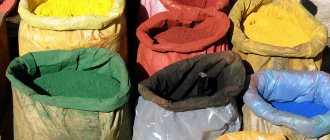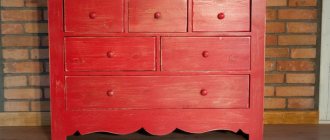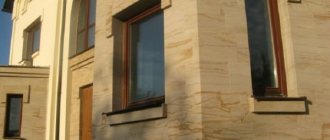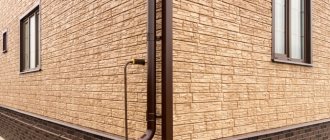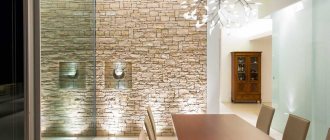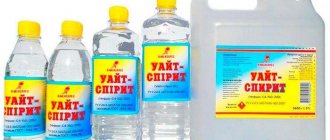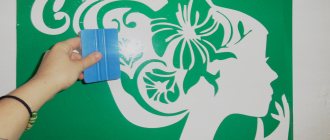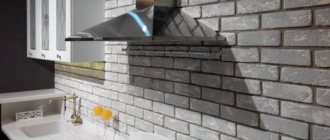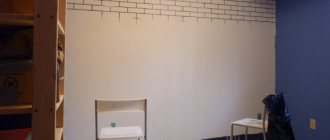A concrete platform adjacent to a house, garage, any building, as well as one built separately (for example, in a recreation area) can be decorated in such a way that it will be difficult to suspect that it is made of concrete.
One of the options for such processing of concrete is painting it, or better yet, etching it with an acid dye. To paint concrete, you can use different paints, including acrylic, polyurethane, epoxy, but they all tightly cover the surface - you can immediately see that this is painted concrete, not stone. And the acid dye gives color, depth, and color heterogeneity - everything, like in a real stone.
Painting concrete to look like stone
Modern fashion trends are widely visible not only in the construction of houses, but also in their decoration. So recently, stone-like painting has become very popular. At the same time, you can paint not only decorative stamped concrete, but also the most common building concrete.
Recently, painting to look like stone has become popular. Decorative stamped and most ordinary concrete can be painted.
You don't need to be a wizard to turn your house into a stone one. All you have to do is pick up a brush or roller and use the tips offered by experts.
In the same way you can decorate the fence and garden path. You can do this yourself.
Coloring
Applying coating with a brush
The paint is applied to a carefully prepared base in several layers. It is very important to apply the composition in thin layers, allowing each layer to dry thoroughly (for at least 12 hours).
Spray painting
Painting concrete: how best to do it when making garden products
Painting concrete is a very important stage for DIYers, and many of them want to learn how to beautifully and reliably paint a self-made concrete figurine, flower vase, decorative stone (short video) and other garden products.
The issue of painting concrete products was partially discussed on the pages of kamsaddeco.com in the manufacture of a two-color flowerpot (short video) and a small vase for a fountain.
Once again, it should be noted that painting concrete (short video) and concrete products is mainly carried out in three ways: introducing a colored pigment into a dry concrete mixture, painting the finished product, and combining the two previous methods.
First method: painting concrete by introducing a colored pigment into a dry concrete mixture
In this case, mineral pigments are usually used, which are oxides or salts of various metals.
For paving slabs and decorative stones on paths, inexpensive iron oxide pigments (FeO, Fe2O3, Fe3O4, etc.) are mainly used, having brown, black, red and yellow colors.
There are organic pigments and dyes (for example, aniline), but they are less resistant to ultraviolet radiation and alkali in concrete. Their advantage is that they give the product a more intense color with low dye consumption.
Since for homemade ones the most important criterion (when making concrete decor) is the minimum cost of the product, we will dwell in more detail on the use of iron oxide pigments.
Iron oxide pigments for concrete
Pigment manufacturers recommend not to exceed a dosage of more than 5%. A larger amount of introduced pigment will lead to a significant deterioration in the characteristics of concrete; it becomes less durable.
To make paving slabs last longer, 2-3% of the pigment by weight of cement is added to the solution. At the same time, it is difficult to obtain a bright color of the product and usually tiles, curbstones, and paving stones have a pale color tint.
Before introducing the pigment into the concrete solution, experts in the production of paving slabs recommend diluting it in a 1:1 ratio and leaving the pigment in a deep penetration primer (such as Ceresit) for 2 hours. There are now a very large number of primers, the choice is up to the master.
In their opinion, this makes it possible to obtain a more uniform color of the product.
In some cases, for example, when using black soot as a pigment, it is necessary to dilute it in the primer, since otherwise, due to its low weight, the soot will float in the concrete solution. If you add it without diluting it into a dry mixture, as many do with iron oxide pigments, then when stirred, the soot becomes very dusty and flies through the air.
But the master may also be faced with another task - uneven coloring of concrete. It is necessary in the manufacture of artificial stone, similar, for example, to marble.
Types and applications
The use of stain to coat concrete improves the performance characteristics of the surface and gives a pronounced decorative effect. A beautiful surface, similar to aged natural stone or marble, looks impressive instead of ordinary concrete, and this solution is very cheap. At the same time, the wear resistance and strength of the base increases.
Stains are widely used for treating floors in premises for various purposes: industrial, utility, residential. On the street, such compositions allow you to decorate any concrete base:
- paths;
- fences;
- pool bowls;
- stairs;
- parapets, etc.
Depending on the purpose and desired result, several varieties are used:
- Epoxy stains provide maximum water protection and are effective in conditions of high humidity. They are highly toxic and therefore can only be used in well-ventilated areas.
- Acrylic stains are non-toxic and can be used for both exterior and interior work in poorly ventilated areas. They have high heat resistance and work well in areas exposed to weather conditions.
- Glossy stains for concrete - decorative compositions for interior work. The surface treated with this material looks very attractive, but its performance characteristics are low. Due to its fragility and susceptibility to mechanical damage, glossy stain is recommended for interior work under conditions of low loads on a base painted with this composition.
- Acid is a relatively new material on the market, which quickly burst into one of the leading positions among analogues. Can be used indoors and outdoors.
In modern conditions, predominantly harmless acrylic and acid compounds are used to treat concrete surfaces with stain. The latter contain inorganic salts dissolved in weak acids; penetrate well into the surface of the base and enter into chemical reactions with concrete components; can create the complete illusion of a marble surface and give a deep translucent color.
Water-based stains contain acrylic components and pigments for a decorative effect. Polymers will fill the pores and surfaces in concrete, creating a film that is resistant, but does not interfere with the vapor permeability of the base, with original uneven coloring or transparent. When using such compositions, there are no chemical reactions, the material is absolutely safe for people, animals and the environment.
Stone impregnation
Make sure the surface of the stone is clean and dry. You can start hydrophobic impregnation.
Impregnation of artificial stone prevents chipping, protects against excessive moisture, premature abrasion, closes pores and strengthens the structure of the stone. Without soaking, the paint will lie unevenly, with “camouflage” spots, and its consumption will also increase significantly.
Hydrophobic compounds come in different forms. It is better to select the most suitable composition for your stone model, for example, choose latex impregnation.
Impregnate the stone at least twice, in as uniform a layer as possible, using brushes, a roller, a sponge or a spray gun for this purpose. After processing, while any of the layers dry, do not allow water to come into contact with the stone.
How to combine with other materials
Paint imitating stone is suitable for the following surfaces:
- walls plastered with gypsum plaster;
- concrete (concrete surfaces);
- wood;
- plastic;
- drywall;
- ceramics;
- glass;
- metal;
- polyurethane.
In order for the coloring composition to perfectly color the surface, a number of preparatory works need to be carried out. It is advisable to clean and level the area to be painted (using gypsum plaster or concrete). Before painting, it is recommended to treat the surface with a primer. The soil is an intermediary that improves traction. It is imperative to prime materials such as plastic, glass, and metal. Rough surfaces have better grip.
True, they are also primed to improve the quality of painting. In addition, the primer saves paint consumption.
After priming and painting the walls, use a finishing varnish (glossy or matte). This product gives the imitation the appearance of natural smooth stone. In addition, the varnish has protective, water-repellent properties.
Preparatory work
Before painting, it is necessary to prepare the concrete surface so that the pigment layer lies evenly and does not peel off. The order is:
- Fill cracks and crevices with cement mortar.
- Carefully run a broom over the concrete to remove debris and dust, then pour water on it, preferably from a hose under strong pressure.
- Remove stubborn stains with a metal bristle brush, use a chemical solvent if necessary, and then wash alternately with soap and clean water.
- Wait for the concrete to dry completely after cleaning.
- Fence the area outside the treated area with oilcloth, plywood or plastic shields.
- Prime the cleaned surface to reduce pigment absorption and increase its adhesion to concrete.
- After polymerization of the primer, paint and varnish compositions are applied.
How to paint concrete outside
Concrete bases outside premises need to be treated to protect them from negative factors: atmospheric, biological, mechanical and others, as well as to create a durable decorative layer. The durability, wear resistance, and water resistance of structures increase.
Treatment of the concrete surface involves the presence of special composites with different chemical compositions:
- oil and latex paints and varnishes;
- enamels and varnishes;
- epoxy;
- acrylic solutions.
Methods for painting concrete outdoors
- Stain . A very affordable method, stain is an inexpensive material, and the coating efficiency is very high. Most often, water-based stains are used with acrylic or acid suspensions as the active substance.
- Rubber paint . It is a solution of pigments and polymers in acrylic latex. The main covering component in this solution is titanium dioxide. After the surface treated with the same composition dries, an elastic film of high strength is formed. It reliably protects concrete from cracking and biological damage by fungus or mold. The coating does not emit harmful substances, is safe and durable, and has a matte finish.
- Epoxy paint . The composition includes pigments dissolved in liquid resin, hardeners and mineral fillers. A method for protecting and decorating both new and old concrete bases.
- Polyurethane varnish . The composition is based on urethane polymers. The surface acquires maximum strength and wear resistance. It is possible to use polyurethane varnishes even at very low temperatures (up to 30 degrees below zero).
Exterior stain
Acrylic or acid stains are used to treat concrete surfaces outdoors.
The acrylic suspension contains coloring polymer composites, which, when applied to a surface, penetrate deeply into the pores and form an impermeable coating. This ensures the preservation of the vapor permeability of concrete, increasing its durability and resistance to precipitation. As it dries, the color becomes more intense.
Acid suspensions contain a weak solution of acids. This material penetrates deeply into the base through a system of capillaries, where chemical reactions occur. The pigments interact with calcium dioxide, resulting in the formation of solid compounds of the chosen color in the concrete structure itself.
Benefits of painting
Painting the fence will make it colorful and attractive, highlight the elements and shape of the slab, highlight the seams and give harmony along the entire perimeter. The photo shows an example of painting a Euro fence, combining the shapes of concrete slabs and an option for combining different color characteristics.
Professional painters have the ability to create attractive paint options that add style and a pop of color to your yard. The façade paint is applied deeply so that the slabs completely absorb the required color.
Are you wondering how to paint a European fence? Tinting with one color or a skillful combination of several colors when painting a fence is always appropriate, fashionable and relevant.
Option for painting the Euro fence
The first impression of your home begins with the fence, so its appearance attracts attention. The fence serves as decoration of the yard and protection of your property. Painting to look like stone or decorated rubble looks great. Small shapes and a variety of slabs create stunning landscape design and emphasize the good taste of the owner.
A cheap and reliable way to transform garden paths using iron sulfate
Gray concrete paths in the garden often irritate their owners; they want to do something with them, for example, paint them in the colors of natural stone, and on a budget and so that after a couple of years the paint does not start to fall off in pieces.
Here is the recipe offered by FORUMHOUSE member Nikolai Ivanovich, Garkusha. He paints the concrete with iron sulfate, and after drying the concrete is difficult to distinguish from natural stone. The only thing: you only need to paint fresh, three-day-old concrete.
The dyeing process is not complicated. A 250-gram packet of iron sulfate is diluted in a bucket of water (if we are talking about small volumes, then 1.5 tablespoons of sulfate per liter of water).
The solution is stirred until the vitriol is completely dissolved in water, after which you can take a brush and start painting.
At first, the color of the concrete will not change at all, but after a while it will turn green.
This should not be scary - when it dries, the concrete will become grayish-yellow, like cobblestone.
On FORUMHOUSE you can learn the exciting story of Nikolay Garkusha’s self-built house, read an article on how to make self-mixed concrete, watch a video on how to make interior partitions from gas silicate blocks yourself.
DIY dyeing steps
The coloring stages include several steps:
Concrete preparation
Before you start painting, remember that poor surface condition will show through the new coat. Cracks and other imperfections will attract attention, so they must be repaired.
Concrete preparation technology step by step:
Applying paint
Adhere to the following rules:
Brush
If you need to give the texture of a decorative stone, you can also use masking tape to mark the boundaries of the design. It is glued to the surface, and after the paint has dried, it is removed.
Spray gun
Using a roller
But rollers are also available with:
- piston system for supplying paints and varnishes;
- automatic feeding system.
The operating technique includes the following actions:
